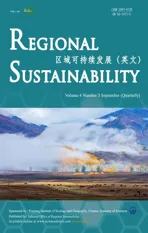Human-wildlife conflict: A bibliometric analysis during 1991-2023
2023-10-24QmerRIDWANZishnAhmdWANINhilANJUMJhngeerAhmdBHATMohdHANIEFShreekrPANT
Qmer RIDWAN, Zishn Ahmd WANI, Nhil ANJUM,Jhngeer Ahmd BHAT, Mohd HANIEF, , Shreekr PANT
a Applied Ecology Lab, Department of Botany, Baba Ghulam Shah Badshah University, Rajouri, 185234, India
b Conservation Ecology Lab, Department of Botany, Baba Ghulam Shah Badshah University, Rajouri, 185234, India
c Piramal Foundation for Education Leadership, Srinagar, 190001, India
d Centre for Biodiversity Studies, Baba Ghulam Shah Badshah University, Rajouri, 185234, India
Keywords:Bibliometrix Human-wildlife conflict Carnivore Wildlife management Coexistence Collaboration analysis
A B S T R A C T
1.Introduction
On a crowded planet, there is a growing conflict between human and wildlife, as they vie for limited space and resources.The encounters between them have become more frequent, and not all interactions between the two groups are positive (Gross et al., 2021).Wildlife can endanger the safety, livelihood, and wellbeing of human, resulting in retaliation against the species responsible and dispute over how to address the situation (Nyhus, 2016).Humanwildlife conflict (HWC) can take various forms, making it challenging to precisely define what constitutes such conflict.The International Union for Conservation of Nature-Species Survival Commission (IUCN-SSC) Human-Wildlife Conflict Task Force defines HWC as a situation where the presence or behavior of wildlife poses an actual or perceived direct and recurring threat to human interests or needs.This leads to disagreements among different groups of people and has negative impacts on both people and wildlife (IUCN-SSC, 2020).HWC poses a significant and escalating threat to the survival of multiple species, and conservation biologists are increasingly focusing on this topic (Dickman, 2010; Zimmermann et al., 2020).The conflict is a global problem, affecting both developed and developing nations (König et al., 2020).Due to current wildlife assemblages and agricultural practices, big mammalian predators and commercial farmers are the archetypes of HWC in the majority of developed nations,including the USA, Norway, Italy, Canada, and Australia.Examples include the brown bear, lynx, grey wolf, and wolverine, all of which prey primarily on sheep and cattle raised for commercial purposes (Seoraj-Pillai and Pillay,2017).The depredation of human and livestock by carnivores, such as tigers and snow leopards in India, leopards in Zimbabwe, Tanzania, and Pakistan, and lions in Africa, is a major source of conflict in developing countries (Carter et al., 2014; Kesch et al., 2015).These occurrences suggest that the geographic distributions of wildlife populations together with farming practices are important predictors of HWC (Seoraj-Pillai and Pillay, 2017).These conflicts have resulted in countless human deaths, financial losses, alterations in the structure and function of ecosystems, and the extinction and decline of various wildlife species that posed the greatest threats (Nyhus, 2016; Gross et al., 2021).Humans have also attempted to reduce threat and damage from those species that survived.However, this trend has changed over the past several decades, as better knowledge, techniques, laws, institutions, and new moral standards have fostered more innovative approaches to managing wildlife and adopting a coexistence model (Treves and Karanth, 2003).Coexistence refers to a sustainable and dynamic relationship between human and large carnivore, in which human and large carnivore adapt to living in shared landscapes and their interactions are regulated by effective institutions to ensure the long-term persistence, social legitimacy, and tolerable levels of risk of carnivore population(Carter and Linnell, 2016).Coexistence does not necessarily mean the absence of conflicts or negative interactions and impacts, but rather how these are managed and understood.Conflicts may still occur within a state of coexistence,but they are well managed (IUCN-SSC, 2022).
The resolution and reduction of HWC is essential for the preservation and recovery of many species, and arguments over how and whether to cohabit with other species create social, economic, and political strifes both inside and among human populations (Redpath et al., 2013).Conflict resolution is a key component of many conservation initiatives since it is difficult to strike a balance between the protection of endangered species and the requirements of local communities (Woodroffe et al., 2005).
Scientific articles on HWC and coexistence have expanded rapidly over the past 20 years (Nyhus, 2016, König et al., 2020).Research on conflict has grown three times faster than research on coexistence, might because the fact that research on human-wildlife interactions has mostly concentrated on conflict (Chapron and Lopez-Bao, 2020) or the new conceptualizations of human-wildlife interactions, which incorporate a coexistence paradigm now.Researchers are looking for ways to refocus conflict research that is pertinent to policy on developing strategies for coexistence and adaptation between human and wildlife (Frank and Glikman, 2019).Different approaches and instruments are needed for efficient research in comprehending HWC and facilitating the promotion and implementation of solutions for sustainable coexistence (König et al., 2020).
Historically, bibliometric measurements have been employed as a proxy indication of research quality at the aggregate level, especially in fields like the biosciences where publication output is still a crucial measure of research advancement (Allen et al., 2009).Bibliometrics is a quantitative method characterized by applying statistics to put up the evolutionary structure of a research topic (Baker et al., 2021).It provides a more reliable analysis and has the potential to launch a systematic, apparent, and reproducible appraisal process (Aria and Cuccurullo, 2017).Bibliometric analysis can be fundamentally used to analyze scientific literature by quantitative means with the help of three bibliometric indicators, including qualitative, quantitative, and structural dimensions (Choudhri et al., 2015;Hasana et al., 2022).It gives us the opportunity to explore the intricate evolutionary dynamics of a particular topic while highlighting the emerging areas in that topic (Donthu et al., 2021a).Bibliometric analysis is used by researchers for a number of purposes, including identifying new patterns in the performance of articles and journals, patterns of collaboration, and research aspects, as well as the examination of the intellectual framework of a particular domain in the existing literature (Donthu et al., 2021b).Bibliometric studies offer incredible opportunities to contribute to theory and practice (Mukherjee et al., 2022).This method is used for measuring the productivity of researchers or for dissecting scientific research (Brika et al., 2021) and can build firm foundations for advancing a field in novel and meaningful ways (Donthu et al., 2021a).
To gain insights into the current state of research and to identify research trends and gaps, a bibliometric analysis of published literature on HWC during January 1991-February 2023 was performed in the present study.The analysis allows for the identification of the most influential authors, publications, countries, and institutions, as well as the most common research topics.By examining the frequency and effect of citations, researchers can evaluate the effect of individual articles and the overall effect of research in the field.This information can be used to highlight areas that require more interdisciplinary research and collaboration and to identify promising avenues for future research on HWC.
More specifically, this article aims to: (1) analyze the publication output on the HWC topic from January 1991 to February 2023; (2) identify the most productive authors, sources, countries, and institutions on the field of HWC research; (3) recognize the most relevant sources on the research topic of HWC; (4) find the most cited authors,sources, and countries on HWC topic; (5) identify country collaborations in publications on HWC; and (6) recognize the most frequently used keywords along with their growth trends on HWC research topic from January 1991 to February 2023.
2.Materials and methods
In the present study, all the indicators (covering qualitative, quantitative, and structural dimensions) were measured after retrieving the relevant literature from the Web of Science (WoS) core collection platform by Clarivate Analytics.A string of appropriate keywords, ‘human wildlife conflict’ or ‘human-wildlife conflict’ or ‘human wildlife interaction’ were used for searching the literature.We considered each displayed publication as a possible contribution to the targeted research topic and extracted the data as a bibtex file.For analyzing the data, ‘Bibliometrix’ tool developed through the R programming language was used, as it is a state-of-the-art tool that follows the classical bibliometric workflow (Aria and Cuccurullo, 2017; Majiwala and Kant, 2023).Data were analyzed for publication trend, most relevant sources, authors, affiliations, and countries, citation and co-citation analysis, country collaboration analysis, keyword analysis, and co-occurrence network analysis.Bibliometric coupling is a method used to determine if two articles have cited the same third article as a reference, which suggests that these articles might share a common objective (Freire and Veríssimo, 2021).Co-citation analysis helps identify similar publications and groups together in clusters (Gmür, 2003).By closely examining a cluster, researchers can uncover a shared field of research among the publications.Small (1973) suggested using co-citation analysis to study the most influential and groundbreaking research within a particular discipline.To limit the set to the most seminal articles, we set a co-citation threshold of 20 (Goyal and Kumar, 2021), meaning that two articles must have been cited together in the reference lists of 20 or more different publications.
3.Results and discussion
3.1.Publication output
The publication output continues to be a crucial indicator of research progression, particularly in the field of biosciences (Allen et al., 2009).While retrieving the published documents on the HWC topic from the WoS, it was found that a total of 1592 documents (in English) have been published during January 1991-February 2023.These documents were extracted from 338 sources, including books, journals, conferences, etc.These academic publications comprise research articles (1427), review articles (77), editorials (14), proceeding papers (9), and others.The total number of references used in these publications is 57,807.There has been a significant increase in the number of publications related to this topic over the years, with just one article published in 1991 and 220 articles published in 2021 with an annual growth rate of 5.16% (Fig.1).This may be due to an increase in the number and severity of HWCs each year, which has been brought on by several reasons like a few wildlife populations are regenerating due to conservation programs and extending into places with people and property, human usage of wildlife habitat is growing in many countries, and environmental shifts such as climate change are pushing some vulnerable species into regions with more people and property (Naughton-Treves and Treves, 2005; Barua et al., 2013; Gargallo, 2021).In the past 15 years, HWC has drawn increased attention from academics and general audiences.Growing awareness of the issue and active research efforts have enhanced knowledge of how HWC may undermine wildlife safeguards and undo conservation progress (Treves, 2009; Seoraj-Pillai and Pillay, 2017).
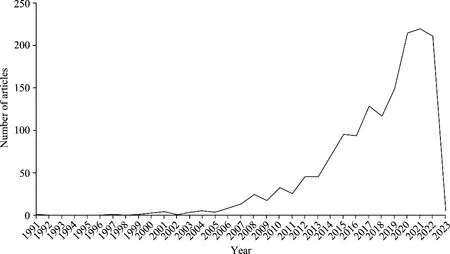
Fig.1.Annual publication production on human-wildlife conflict (HWC) research topic during January 1991-February 2023.
3.2.Most productive authors, sources, countries, and institutions
Bibliometric studies often consider the most productive authors, journal sources, countries, and institutions as important indicators to identify leading contributors within a specific research field (Singh et al., 2022).The present study reveals that a total of 4995 authors have contributed to the targeted research field through their research contributions.Out of these, 111 authors have contributed to single-authored documents and 4884 authors to multiauthored documents.Author David Macdonald from the University of Oxford, United Kingdom (UK) has produced the maximum number of publications (29 publications), followed by Andrew Loveridge (15 publications), and Catherine Hill (14 publications) (Table 1).
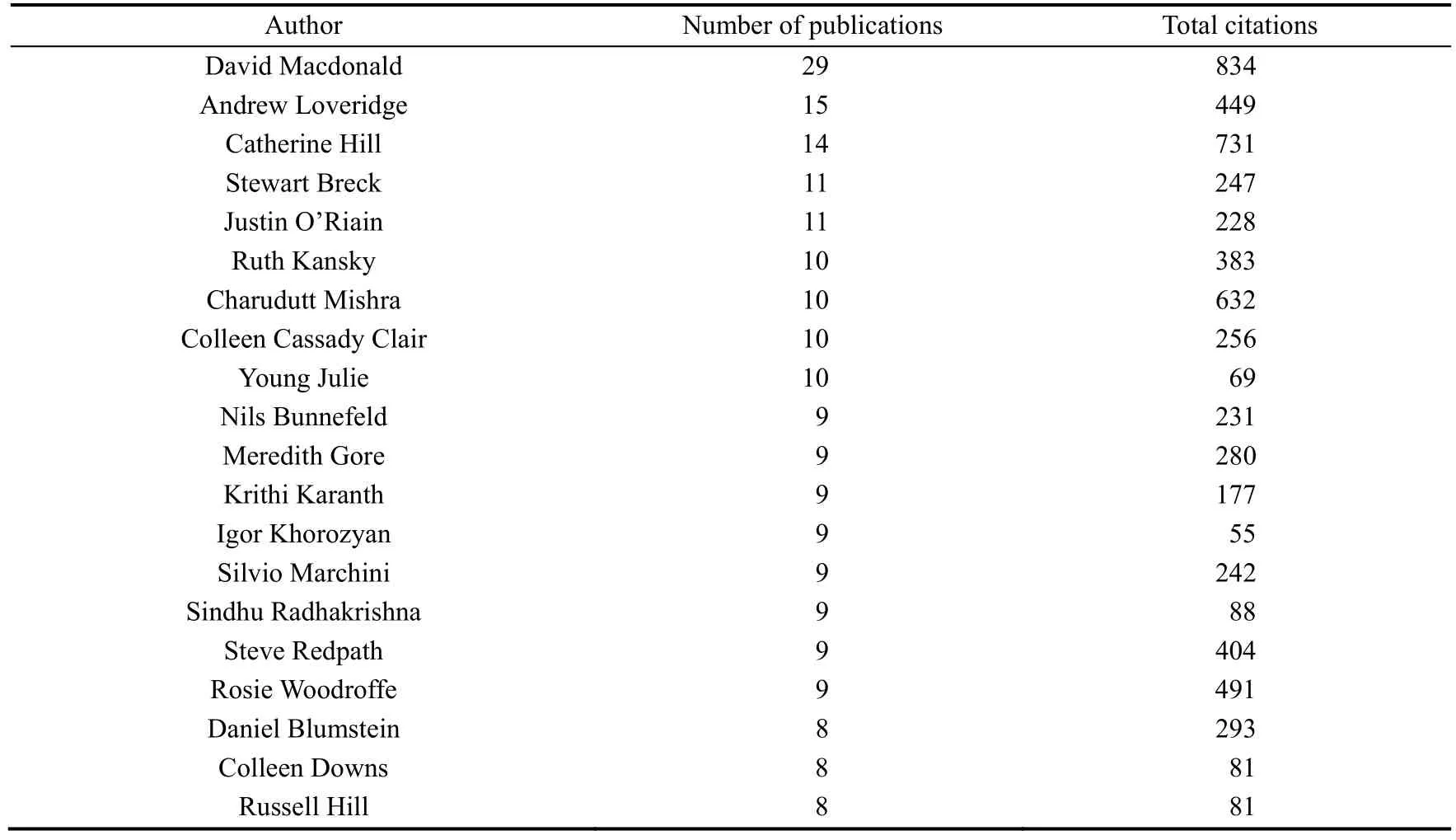
Table 1Top 20 productive and cited authors related to human-wildlife conflict (HWC) research topic during January 1991-February 2023.
A power-law distribution describes the relationship between the number of authors and the number of articles they published (Lotka, 1926).This is referred to as Lotka’s law, which is a well-known empirical pattern that reflects the distribution of scientific productivity among researchers (Ahmi et al., 2020).Lotka’s law implies that a few authors,usually known as ‘‘core authors’’, bear responsibility for most of the published articles, while the majority of authors only publish a small number of articles (Lotka, 1926).On examining articles and authors within the framework of Lotka’s law, it was revealed that 82.24% of authors contributed with a single publication, 11.10% with 2 publications,3.52% with 3 publications, and only 3.14% with more than 3 publications (Table 2).
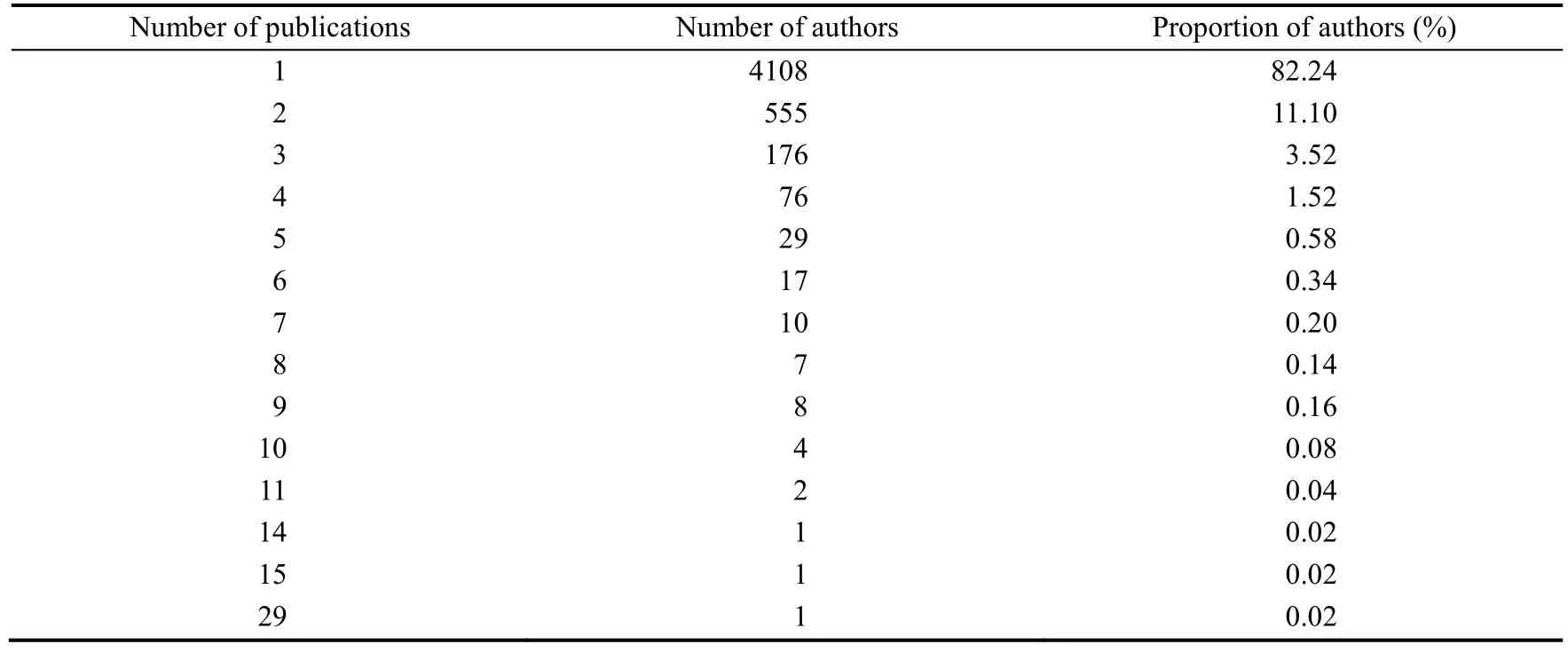
Table 2Number of articles by the authors related to HWC research topic during January 1991-February 2023.
Out of the 388 sources, the journal ‘Biological Conservation’ is the most important and productive, with a total of 104 publications.The next most relevant source is ‘Oryx’, with 88 publications, followed by ‘Human Dimensions of Wildlife’, with 60 publications (Table 3).
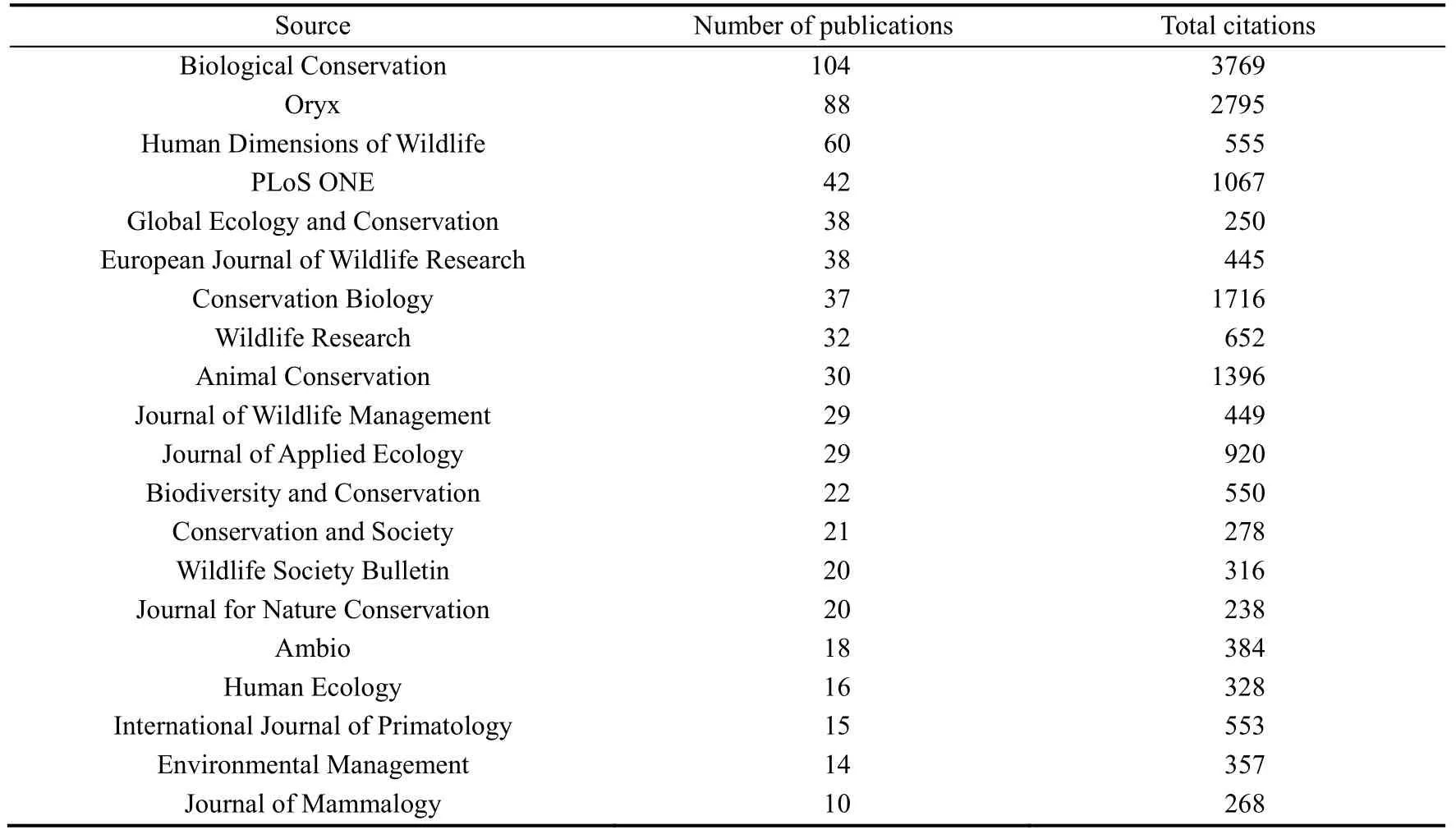
Table 3Top 20 productive and cited scientific journal sources related to HWC research topic during January 1991-February 2023.
Bradford’s law, a bibliometric principle that describes the relationship between journals and the articles published on a specific topic, states that a small group of journals, known as ‘‘core sources’’, contain a significant proportion of the articles related to that topic.This means that the majority of articles on a particular topic are concentrated in a small number of core journals (Gourikeremath et al., 2021).Based on Bradford’s law, among the total 388 sources,only 11 journals belong to the core sources (Fig.2).
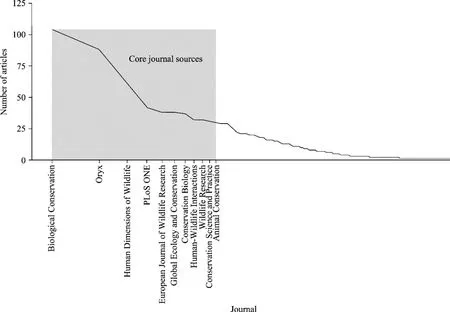
Fig.2.Core scientific journal sources related to HWC research topic during January 1991-February 2023 based on Bradford’s law.
Based on the country production analysis, authors from 110 countries have contributed to the field.The USA has the highest frequency of publications on HWC research (1891 publications), followed by the UK (841 publications),Australia (478 publications), South Africa (381 publications), China (295 publications), India (292 publications),Germany (266 publications), Canada (222 publications), Spain (168), Brazil (144), and Nepal (116).This trend indicates their active involvement in research on HWC.Several factors contribute to this pattern, including their strong interest in conservation, the availability of funding resources, and access to prestigious journals with a broader readership and impact.In the Himalayan biodiversity hotspot, China, India, and Nepal are the only three countries to produce a significant number of publications in the relevant field.Other countries like Pakistan and Bhutan have produced 36 and 19 publications in this field, respectively.
From the perspective of the most productive institutions, ‘University of Oxford’ tops the list with 165 articles,followed by ‘Colorado State University’ (74 articles), ‘University of California, Davis’ (66 articles), ‘University of Kent’ (60 articles), and ‘University of Cape Town’ (59 articles) (Fig.3).This ranking allows for accurate comparisons among institutions regarding the internationality of their publication patterns, the frequency of publishing in peerreviewed sources, the frequency of publishing in esteemed journals within the discipline, and the distribution of their publications between scientific and high-level synthetic literature (Wallin, 2005).
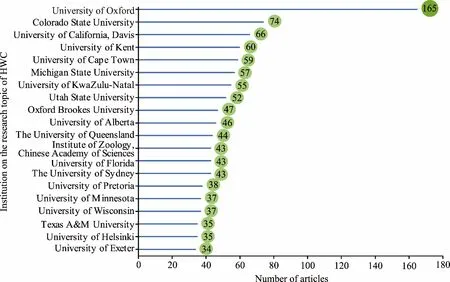
Fig.3.Top 20 most productive institutions on HWC research topic during January 1991-February 2023.
3.3.Citation and co-citation analysis
Citation analysis represents the study of the influence of articles and is considered one of the standard instruments for impact evaluation (Rejeb et al., 2022).Citations also reflect the importance and vitality of the papers’ contributions to the literature on a specific topic (Sharma et al., 2022).In the present study, on average, each document has been cited by 18.52 times.The most globally cited documents on HWC include Dickman (2010), Inskip and Zimmermann(2009), and Schley and Ropar (2003) (Table 4).Dickman (2010) highlights the importance of considering social factors in understanding HWC and developing effective mitigation strategies.While direct wildlife damage is often seen as the main driver of conflict, Dickman (2010) argues that social factors such as religious affiliation, ethnicity,and cultural beliefs also play a significant role.Furthermore, it is suggested that conflict is often a manifestation of underlying human-human conflicts, such as those between authorities and local people or between people of different cultural backgrounds.As such, it’s crucial to take a comprehensive and interdisciplinary approach to conflict resolution that considers social, cultural, and political factors in addition to technical measures for reducing wildlife damage.By broadening our understanding of conflict drivers, we can better identify patterns and underlying processes behind HWC and develop more effective strategies for promoting coexistence between people and wildlife.
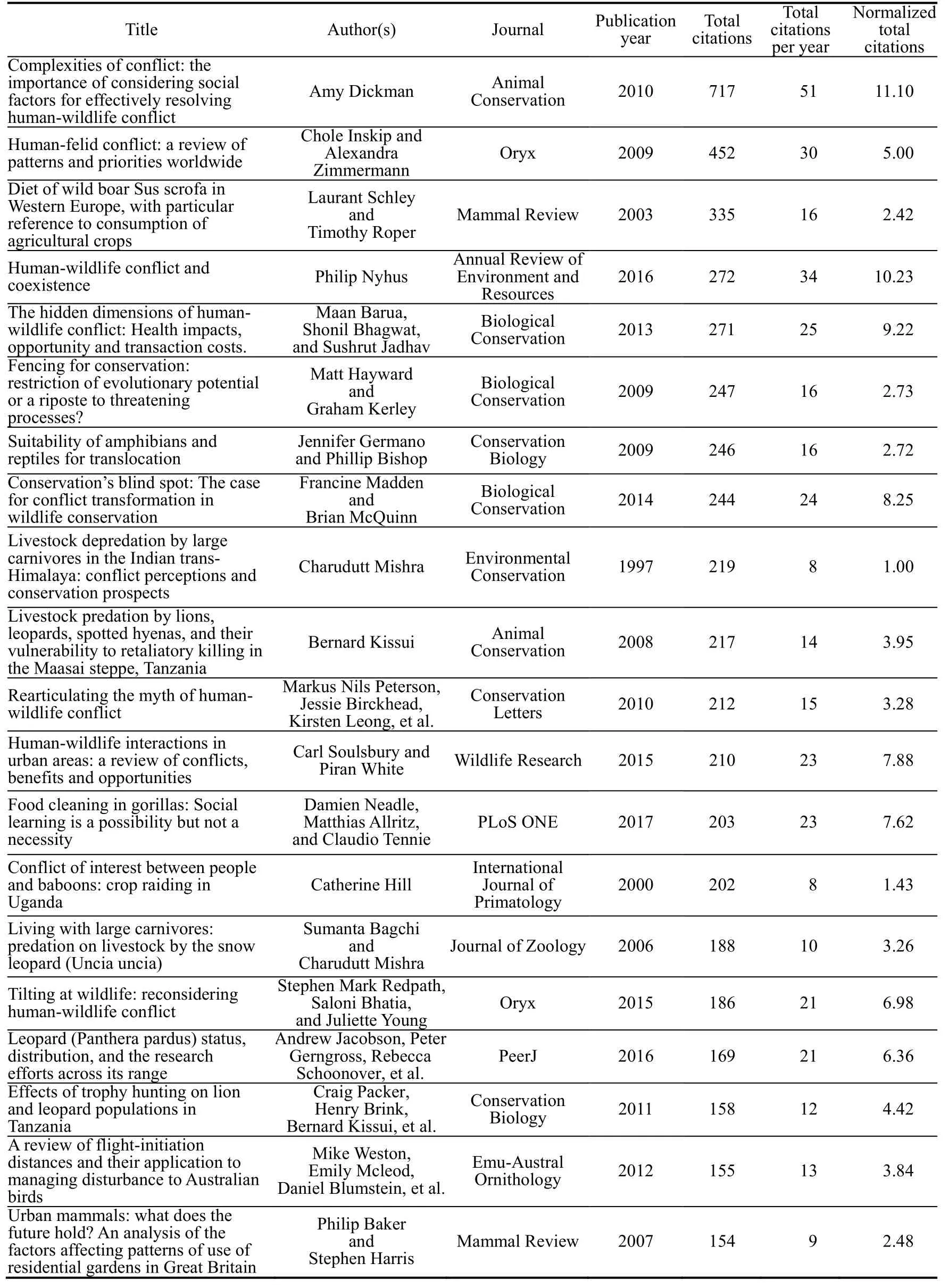
Table 4Top 20 global cited articles on the HWC research topic during January 1991-February 2023.
The second most cited document published by Inskip and Zimmermann (2009) highlights the urgent need to address human-felid conflict, which is a major conservation issue for wild cat species worldwide.The authors conducted a systematic review of human-felid conflicts, using a combination of literature review and Geographical Information System (GIS) analysis to assess the patterns and determinants that influence the severity of these conflicts.The study found evidence of conflict affecting over 75.00% of the world’s felid species, with conflict the severity of conflict increasing as the body masses of felid increase.The study identified nine species: caracal, cheetah, Eurasian lynx,jaguar, leopard, lion, puma, snow leopard, and tiger, as being of greatest conservation significance due to the severity of conflict.The authors called for more rigorous evaluation of management strategies, which have only been evaluated scientifically in 31.00% of cases.Standardized reporting techniques are also needed to facilitate the resolution of patterns and trends in the scale of human-felid conflict worldwide.The authors emphasized the importance of developing a thorough understanding of the dynamics of human-felid conflicts to develop effective management strategies and promote the coexistence of human and felids.
The third most cited document published by Schley and Roper (2003) reviews the diet of wild boars in Western Europe, with a focus on the consumption of agricultural crops and its implications for crop damage.They used data from 11 studies that provide quantitative information on the consumption of different food types and listed all the foods reported as being eaten by wild boars in a total of 21 studies.They found that vegetable foods are more frequently consumed by wild boars than animal foods and constitute the bulk of their diet.The major vegetable food categories include masts, roots, green plant matter, and agricultural crops.Among animal foods, insects, earthworms,birds, and mammals are eaten most consistently.The diet of wild boars also includes amphibians, reptiles, gastropods,and myriapods.The authors observed that wild boars are opportunistic omnivores whose diet, in any particular instance, is largely determined by the relative availability of different food types.Seasonal, interannual, and regional differences in the diet indicate that it is highly variable.However, their dependence on energy-rich plant material as a major component of the diet, coupled with their large body size and a propensity to trample crops, means that wild boars cause significant agricultural damage.
Among the authors, David Macdonald has received the maximum impact with 834 citations, followed by Catherine Hill (731 citations) and Charudutt Mishra (632 citations) (Table 1).Among the sources, the journal ‘Biological Conservation’ tops the list with the highest number of citations (3769 citations), followed by ‘Oryx’ (2795 citations)and ‘Conservation Biology’ (1716 citations) (Table 3).Among the most cited countries, the USA ranks at the top with 8085 citations, followed by the UK (6928), Australia (2455), South Africa (1318), India (1292), and Canada (949)(Fig.4).
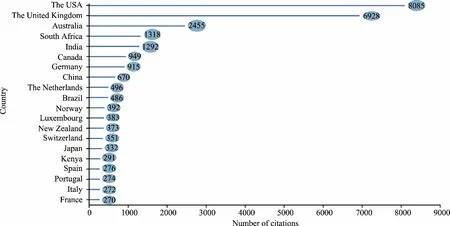
Fig.4.Top 20 most cited countries on the HWC research topic during January 1991-February 2023.
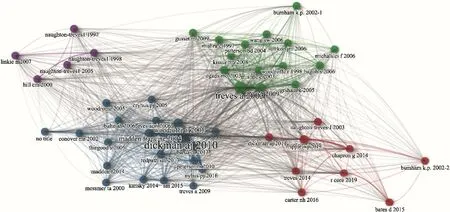
Fig.5.Co-citation network of the studies on the HWC research topic with article as the unit of analysis.The width of the connective line between two nodes shows the degree of co-citation, and the size of the node indicates how many citations the article has received.Red nodes represent articles focusing on human-carnivore conflicts, blue nodes represent articles focusing on the complexity of HWCs and multiple factors in conflict resolution, green nodes represent articles focusing on the issue of livestock predation by carnivores and its impact on human livelihoods, and violet nodes represent articles focusing on crop raiding by wildlife.
The co-citation network of studies on HWC, keeping articles as the unit of analysis, is shown in Figure 5.A total of 50 articles meet the threshold by keeping the minimum citations at 20 and forming 4 clusters.The width of the connective line between two nodes shows the degree of co-citation, while the size of the node indicates how many citations the article has received (Singh et al., 2022).During the present study, four clusters were formed in co-citation network.The first cluster (red) comprised 9 articles.The articles in this cluster focus on human-carnivore conflicts,emphasizing the vulnerability of carnivores to extinction and advocating for their conservation and protection.For example, Naughton-Treves et al.(2003) provide insights into the social dynamics and attitudes surrounding wolf management, highlighting the significance of social identity and occupation as predictors of tolerance.They conducted a study in Wisconsin State to investigate whether individuals who experienced domestic animal losses to wolves or other predators are less tolerant of wolves compared to their neighbors who did not experience such losses.They also explored the impact of compensation payments on tolerance.The study found that the strongest predictor of tolerance is social group, as bear hunters are more likely to approve of lethal control and reduce the wolf population than livestock producers.Interestingly, compensation payments did not improve tolerance among those who had suffered losses to wolves.However, all respondents approved of compensation payments as a management strategy.
Dickman et al.(2011) explain that the challenge of protecting highly valued species, such as large predators, is complicated by their negative impacts on local economies and the difficulty of reconciling the diverse dimensions of costs and benefits involved in conservation.Financial incentives, such as ‘‘payments to encourage coexistence’’, can play a key role in promoting human-carnivore coexistence and reducing poverty in affected communities.In light of these challenges, the authors proposed a coordinated effort to promote carnivore conservation and alleviate poverty through the combination of existing financial strategies such as compensation, insurance, revenue sharing, and conservation payments.This approach would require a nuanced understanding of the complex political and economic dimensions of large carnivore conservation but could ultimately yield tangible benefits for both humans and carnivores.
Ripple et al.(2014) assess threats to carnivores and highlight the need to maintain minimum population densities for the persistence of carnivores and ecosystem integrity.Due to their high metabolic demands, large carnivores require expansive habitats and often come into conflict with human and livestock.These conflicts, coupled with habitat loss, have resulted in significant population decline.Large carnivores provide economic and ecosystem services and impact various species and ecosystem processes.Preserving their populations is vital for resilient ecosystems.The authors proposed a Global Large Carnivore Initiative (GLCI) to coordinate research, conservation practice, and policy efforts.The formation of a GLCI would be an important step for the advancement of international public recognition of the ecological role and inherent value of large carnivores, and for developing and coordinating strategies for conservation actions that promote human/large-carnivore coexistence.According to Chapron and Lopez-Bao (2014), large carnivores not only provide ecological services but also political services.The political factors may pose challenges in gaining strong commitment for the implementation of GLCI due to incentives to scapegoat large carnivores.They recommended developing a better understanding of the political ecology of large carnivore conservation.According to Carter and Linnell (2016), there is a crucial need to incorporate large carnivore species into multi-use landscapes beyond protected areas.However, the lack of a clear understanding of coexistence poses a challenge in achieving this objective.They proposed a conceptualization of coexistence that emphasizes the importance of mutual adaptations by both large carnivores and human.
The second cluster (blue) is the largest cluster, with 20 articles, including the highest cited document (Dickman,2010).These articles highlight the complexity of HWCs and the importance of considering multiple factors in conflict resolution.The articles suggest that conflict transformation rather than management is key to achieving sustainable coexistence between human and wildlife.Madden and McQuinn (2014) emphasized the need to go beyond surfacelevel conflicts and delve into the underlying social conflicts to improve the effectiveness of conservation initiatives.By reconciling these conflicts and increasing social receptivity to conservation goals, the article suggests that the social carrying capacity for many species can be enhanced.Peterson et al.(2010) argue that the phrase ‘‘humanwildlife conflict’’ is detrimental to coexistence between human and wildlife because it reinforces a perception of animals are antagonistic to human.They suggested reframing the relationship between human and wildlife using a comic approach to facilitate a more productive interpretation of their relationship.The authors highlighted the importance of language in shaping perceptions and attitudes towards human-wildlife relationships.They suggested that a shift away from the language of conflict towards a more nuanced and positive framing could improve coexistence between human and wildlife.
Treves et al.(2006) argue that the extension of wildlife corridors beyond protected areas must consider the economic and political implications of HWC.They suggested a strategy for mitigating such conflict based on participatory methods and co-management with the twin objectives of wildlife conservation and safeguarding human security.The authors drew on their experiences in Bolivia, Uganda, and Wisconsin State, the USA to outline the importance of incorporating local stakeholders as partners in planning and implementation to win space for wildlife beyond protected area boundaries.They also highlighted the significance of a systematic study of local people’s perceptions of risk and participant planning of interventions to ensure the success of such projects.The authors emphasized the need to move the traditional response of killing ‘‘problem’’ wildlife and transforming wild habitats to adopt a collaborative and participatory approach to conservation that considers both human and wildlife needs.
Redpath et al.(2013) argue that the increasing number of conservation conflicts needs to be managed to minimize negative impacts on biodiversity, human livelihoods, and well-being.They suggested that effective conflict management requires recognizing shared problems, engaging with clear goals and a transparent evidence base, and being aware of trade-offs.They also hypothesized that conservation outcomes will be less durable if conservationists prioritize their interests over others.To achieve long-term conservation benefits, the underpinning social context needs to be better integrated with the material impacts and evaluation of alternative conflict management approaches.
Barua et al.(2013) survey the hidden impacts of HWC in low-income countries, particularly on the wellbeing of communities that interface closely with wildlife.While approaches to mitigating conflict often focus on its visible costs, such as crop damage or loss of livestock.The authors argued that hidden impacts, such as psychosocial wellbeing and disruption of livelihoods, remain poorly addressed.The paper presents an account of the known and potential hidden impacts of HWC and investigates their effects on rural communities.The authors argued that hidden impacts include diminished psychosocial wellbeing, disruption of livelihoods, food insecurity, and considerable opportunity costs of crop and livestock guarding.When seeking compensation for damage, bureaucratic inadequacies result in added transaction costs.The paper concludes by identifying gaps in knowledge and outlining areas for future research to better address the hidden dimensions of HWC.The authors emphasized that communities may be tolerant of wildlife, while the hidden impacts of conflict jeopardize various components of global wellbeing.Addressing these hidden impacts is critical to the integration of poverty alleviation and biodiversity conservation.
The third cluster (green) is the second largest cluster, containing 15 articles, particularly focusing on the issue of livestock predation by carnivores and its impact on human livelihoods.The articles explore various aspects of this conflict, including its spatial and temporal characteristics, ecological correlates, management strategies, and the role of incentive programs in mitigating the conflict.They also examine the hidden impacts of HWC on rural communities,such as psychosocial wellbeing, disruption of livelihoods, and food insecurity.The articles draw from case studies in different regions, such as Bhutan (Wang and Macdonald, 2006), Kenya (Patterson et al., 2004; Kolowski and Holekamp, 2006), the Indian trans-Himalaya (Mishra, 1997) etc., to provide insights into the complex and dynamic nature of the conflict and to identify gaps in knowledge and areas for future research.In general, the third cluster highlights the need for a holistic and collaborative approach to managing HWC that balances the conservation of biodiversity with the wellbeing of local communities.
The fourth cluster (violet) is the smallest cluster, with only five articles, focusing on crop raiding by wildlife,particularly wild boars, pig-tailed macaques, and baboons, in different regions.The articles explore the patterns,causes, and impacts of crop raiding on farmers living near national parks and forest reserves in different regions,including Sumatra (Linkie et al., 2007) and Uganda (Naughton-Treves, 1997; Naughton-Treves et al., 1998; Hill et al., 2000).Crop raiding is most prevalent in areas closest to the forest edge, and the existing protective measures implemented by local farmers have been proven to be ineffective (Hill et al., 2000; Linkie et al., 2007).The establishment of agroforestry buffers along the edges of the national parks creates favorable conditions for crop raiders by providing them with an ideal habitat (Naughton-Treves et al., 1998).The articles highlight the need for alternative mitigation strategies, increased guarding efforts during specific seasons (Linkie et al., 2007), consideration of physical and social factors influencing crop damage, and implications for conservation policies and practices (Hill et al., 2000).
3.4.Collaboration analysis
Rising trend in the number of article authors is, at least in part, a reflection of the fact that scientific research is becoming a more collaborative, interdisciplinary, multi-location, and multi-funded process (Wuchty et al., 2007).While this growing tendency is also believed to be related to research assessment programmes like the Research Excellence Framework (RAE) of the UK, it is also expected to persist in fields where there is value in ‘‘large’’,collaborative, and international science.This, in turn, is likely to contribute to higher author numbers and citation rates (Allen et al., 2009).In the present study, out of the total 1592 documents, only 125 are single authored, whereas 1467 are multi-authored, with 4 average co-authors per document and 48.87% international co-authorships.The USA has the highest multiple country publications (MCP), followed by the UK, Australia, India, and South Africa (Fig.6).The USA has collaborated with 88 countries and it has the highest frequency of collaboration with the UK (102 times),followed by India (48 times), Australia (45 times), and South Africa (40 times).This means that HWC is not limited by geopolitical boundaries and requires interdisciplinary research, shared knowledge, and coordinated efforts across countries and regions.These findings can be useful for fostering international cooperation, coordinating research efforts, and developing effective strategies to mitigate HWC.
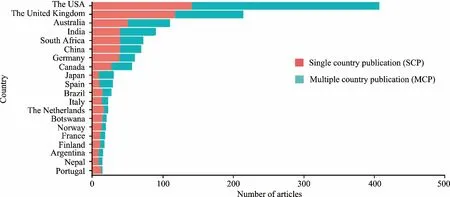
Fig.6.Most 20 relevant countries on the HWC research topic.SCP indicates publication with author(s) from only one country and MCP indicates publications with author(s) from multiple countries.
3.5.Keywords analysis
Keyword analysis, which is a valuable tool for identifying broader research trends and directions, involves gathering the keywords from all relevant publications within a specific field.This process helps to uncover the primary areas of focus and emerging themes in research (Rejeb et al., 2022).For each article dealing with the HWC, original author keywords, used by the authors in the articles were examined.Author keywords serve as indicators of the main themes addressed in research articles (Goyal and Kumar, 2021).A total of 4470 keywords have been used by the authors to classify their studies on HWC research topic from January 1991 to February 2023.The most frequently occurring keywords typically express the most trending topics of the year.The most frequently used keywords include‘human-wildlife conflict’ (858 times), ‘conservation’ (151 times), ‘conflict’ (138 times), ‘human-wildlife’ (108 times), ‘carnivore’ (94 times), ‘wildlife’ (83 times), ‘wildlife management’ (65 times), ‘livestock’ (64 times),‘management’ (60 times), and ‘coexistence’ (51 times) (Fig.7).
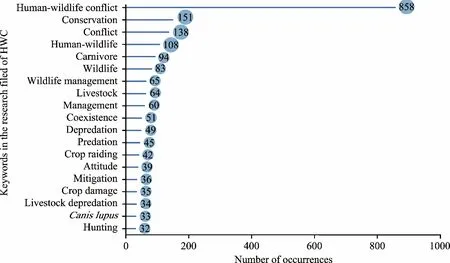
Fig.7.Top keywords with the number of occurrences being higher than 30 in publications on the HWC research topic during January 1991-February 2023.
The co-occurrence network of keywords includes six clusters (Fig.8).These clusters provide the main thematic areas within the research filed of HWC.The first cluster (red) is dominated by keywords related to carnivores and the interactions with human and livestock.It consists of seven keywords, including ‘livestock predation’, ‘carnivore conservation’, ‘leopard’, ‘Panthera pardus’, ‘Panthera leo’, etc.The second cluster (blue) is dominated by keywords related to the management of HWCs, conservation, and local perception.It is the largest cluster, consisting of 22 keywords, including ‘human-wildlife conflict’, ‘conservation’, ‘wildlife’, ‘wildlife management’, ‘tolerance’,‘mitigation’, etc.The third cluster (green) is dominated by keywords related to HWCs with respect to large herbivores like elephants.It comprises only four keywords, including ‘human-elephant conflict’, ‘human-wildlife interactions’,‘Botswana’, and ‘elephants’.The fourth cluster (violet) is the second largest cluster, consisting of 13 keywords,including ‘livestock’, ‘crop damage’, ‘crop raiding’, ‘Canis lupus’, ‘Ursus arctos’, ‘carnivore’, ‘depredation’,‘predation’, etc.The fourth cluster shares some similarities with the first cluster, as they both revolve around carnivores and their influence on human-livestock interactions.However, the first cluster has a broader focus on carnivore conservation and their overall interaction with human, while the fourth cluster delves deeper into the specific aspect of livestock-related conflict, including crop damage, depredation, and predation.The fifth cluster (yellow) consists solely of the keyword ‘conflict’, suggesting a general focus on conflict itself.The sixth cluster (brown) contains only the keyword ‘human-wildlife’ and centers on the broader relationship between human and wildlife.
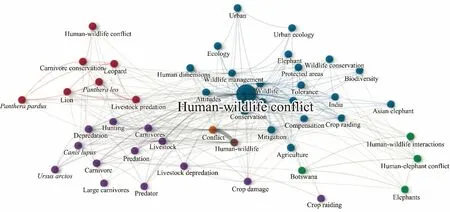
Fig.8.Co-occurrence network of keywords on the HWC research topic during January 1991-February 2023.Keywords are represented by points, and the proximity of points indicates the frequency of their co-occurrence in the articles, i.e., points that are closer together signify a higher likelihood of being mentioned together in the articles,while points that are farther apart indicate a lower likelihood of co-occurrence.The width of the connective line between two points shows the degree of correlation.Red points represent keywords related to the interaction between carnivore and human and livestock; blue points represent keywords related to the management of HWCs,conservation, and local perception; green points represent keywords related to HWC with respect to elephant; violet points represent keywords related to the interaction between carnivore and livestock; yellow points represent keywords of conflict; brown points represent keywords of human-wildlife.
4.Limitations and recommendations
The study recognizes several limitations that can be addressed in future research.Firstly, the samples used in the study only include journals indexed in the WoS, which may not fully represent the entire range of research on HWC.To overcome this limitation, future studies could incorporate alternative indexing sources like Scopus, Google Scholar, or specialized databases to ensure a more comprehensive analysis of the literature.Secondly, while the study utilizes the “Bibliometrix” tool developed with the R programming language, there are other tools available such as BibExcel, CiteSpace, Eigenfactor Score, Hist Cite, and Pajek that could provide additional insights into the literature.Researchers could consider employing these tools to complement and enhance the analysis of HWC literature.
In the present study, the utilized publications are conducted only in English, potentially excluding relevant research published in other languages.Since HWC is a global issue and scholars from various regions conduct research on this topic, it is possible that valuable findings are published in languages other than English, particularly in countries where English is not the primary language for scholarly communication.Consequently, there is a risk of overlooking important research by solely focusing on English-language publications.Future studies should consider including publications in other languages to obtain a more diverse and comprehensive view.This could involve using multilingual search strategies or collaborating with researchers proficient in other languages.By doing so, the study findings can be enriched, and a more inclusive understanding of the field of HWC can be achieved.Moreover, the field of HWC is dynamic and constantly evolving with new research emerging regularly.The findings of the study are limited by the available data and period of analysis.Future studies could conduct longitudinal analyses to track changes in research trends and directions over time.
Furthermore, it is important to understand the complexities of HWC across continents and countries to develop effective strategies for managing these conflicts.Collaborative studies on HWC that involve researchers and practitioners from developing and underdeveloped nations should be encouraged.This will not only increase the diversity of perspectives and approaches but also promote local ownership and participation in the research and management of HWC.Collaborative studies can also help to build capacity and expertise in these regions, which can lead to more effective conservation and management practices in the long run.In addition, collaborative studies can increase the impact of the research by reaching a wider audience and generating more attention and support for HWC issues.This can lead to greater awareness, advocacy, and policy changes that can help to address the underlying causes of HWC.Moreover, collaborative studies can help to promote equitable partnerships and knowledge-sharing, which are critical for addressing global conservation challenges such as HWC.More research should be conducted on HWC in developing countries, specifically in Nepal, Bhutan, Pakistan, and India, which are part of the Himalayan biodiversity hotspot.This is because there is a lack of information on this issue in these regions, as evidenced by the low number of publications related to HWC that have been produced in these regions over the last 30 years, even though they are home to some of the most significant wildlife habitats and species in the world.The research should focus on understanding the drivers of HWC in these regions and developing strategies to mitigate and manage conflict.It should also involve local communities, who often bear the brunt of HWC, and seek to empower them to play a more active role in wildlife conservation.It is important to recognize and value the knowledge, skills, and experiences of researchers and practitioners from different regions and cultures, and work together to find innovative solutions that work for everyone.
5.Conclusions
The consequences of HWC are far-reaching, including the extinction and decline of numerous species, human fatalities, financial losses, and ecological disruptions.Conservation biologists have increasingly recognized the urgency of addressing this issue, as evidenced by the growing number of publications on the topic over the past three decades.The bibliometric analysis conducted in this study provides valuable insights into the prolific authors, sources,institutions, and countries in the research field of HWC, and provides valuable insights for researchers to choose suitable platforms and foster collaborations.Developed nations, including the USA, the UK, and Australia, display the highest frequency of publications and citations, reflecting their active engagement in HWC research.This pattern could be attributed to various factors, including their strong conservation interest, availability of funding resources,and access to prestigious journals with a wider reach and impact.India is the only developing country that is among the top ten most productive countries with regard to the number of publications and citations.It is crucial to emphasize the importance of promoting research initiatives in developing countries as well, where HWC may have received less attention, as evidenced by the lesser number of publications from these countries on HWC.Encouraging collaborations, improving capacity-building programs, and enhancing targeted funding opportunities in these regions can help address the imbalance in HWC research and enhance conservation efforts on a global scale.Moreover, it is recommended to promote interdisciplinary approaches to HWC research, fostering collaborations between conservation biologists, social scientists, policy-makers, and local communities.Such interdisciplinary efforts can lead to a more holistic understanding of HWC and the development of effective mitigation strategies.
Authorship contribution statement
Qamer RIDWAN: data curation, formal analysis, writing - original draft, and writing - review & editing; Zishan Ahmad WANI: conceptualization, data curation, formal analysis, writing - original draft, and writing - review &editing; Nahila ANJUM: writing - review & editing; Jahangeer Ahmad BHAT: writing - review & editing; Mohd HANIEF: writing - review & editing; Shreekar PANT: writing - review & editing.
Declaration of competing interest
The authors declare that they have no known competing financial interests or personal relationships that could have appeared to influence the work reported in this paper.
杂志排行
区域可持续发展(英文)的其它文章
- Measuring the agricultural sustainability of India: An application of Pressure-State-Response (PSR) model
- Impact of taxes on the 2030 Agenda for Sustainable Development: Evidence from Organization for Economic Cooperation and Development (OECD) countries
- Geotechnical and GIS-based environmental factors and vulnerability studies of the Okemesi landslide, Nigeria
- Environmental complaint insights through text mining based on the driver, pressure, state, impact, and response (DPSIR)framework: Evidence from an Italian environmental agency
- Expert elicitations of smallholder agroforestry practices in Seychelles: A SWOT-AHP analysis
- Examination of the poverty-environmental degradation nexus in Sub-Saharan Africa
